People Work & Employment: Nike's HR Sustainability Case Study
VerifiedAdded on 2023/06/08
|10
|2230
|123
Case Study
AI Summary
This case study analysis delves into Nike's HR sustainability initiatives from 1998 to 2013, examining the company's efforts to address labor practices and promote sustainable development. It highlights key initiatives such as promoting the CR team, introducing sustainability indexes, and improving safety policies. The analysis assesses the authenticity of these initiatives, their contribution to enhancing human resources, and the differences between the initiatives and the broader business context. It also explores the role of governmental assistance, the Fair Labor Association, and strategic alliances in improving labor conditions and driving sustainable growth within Nike's global operations, ultimately concluding that while progress has been made, continuous improvement is essential for achieving benchmark performance levels.
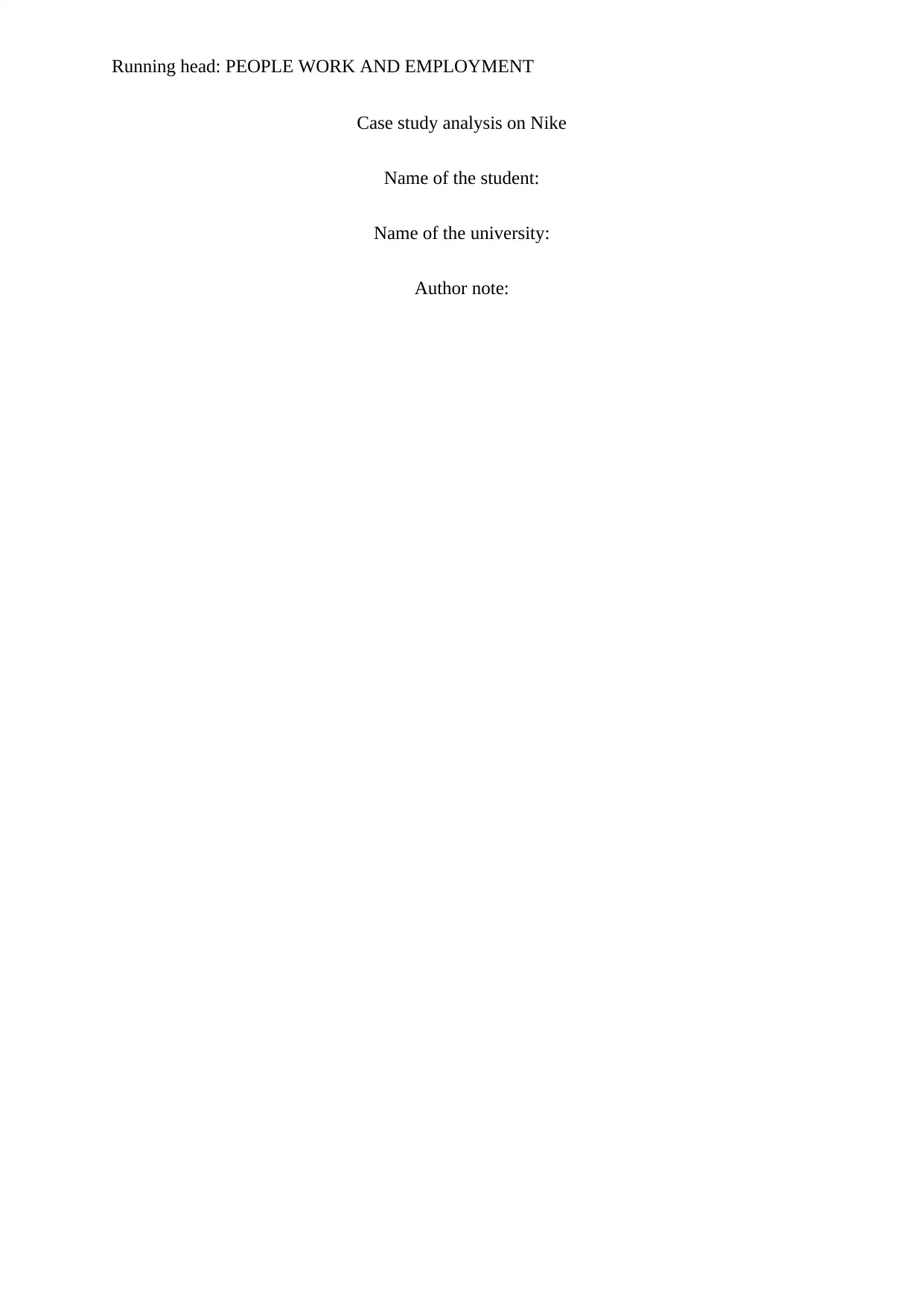
Running head: PEOPLE WORK AND EMPLOYMENT
Case study analysis on Nike
Name of the student:
Name of the university:
Author note:
Case study analysis on Nike
Name of the student:
Name of the university:
Author note:
Paraphrase This Document
Need a fresh take? Get an instant paraphrase of this document with our AI Paraphraser
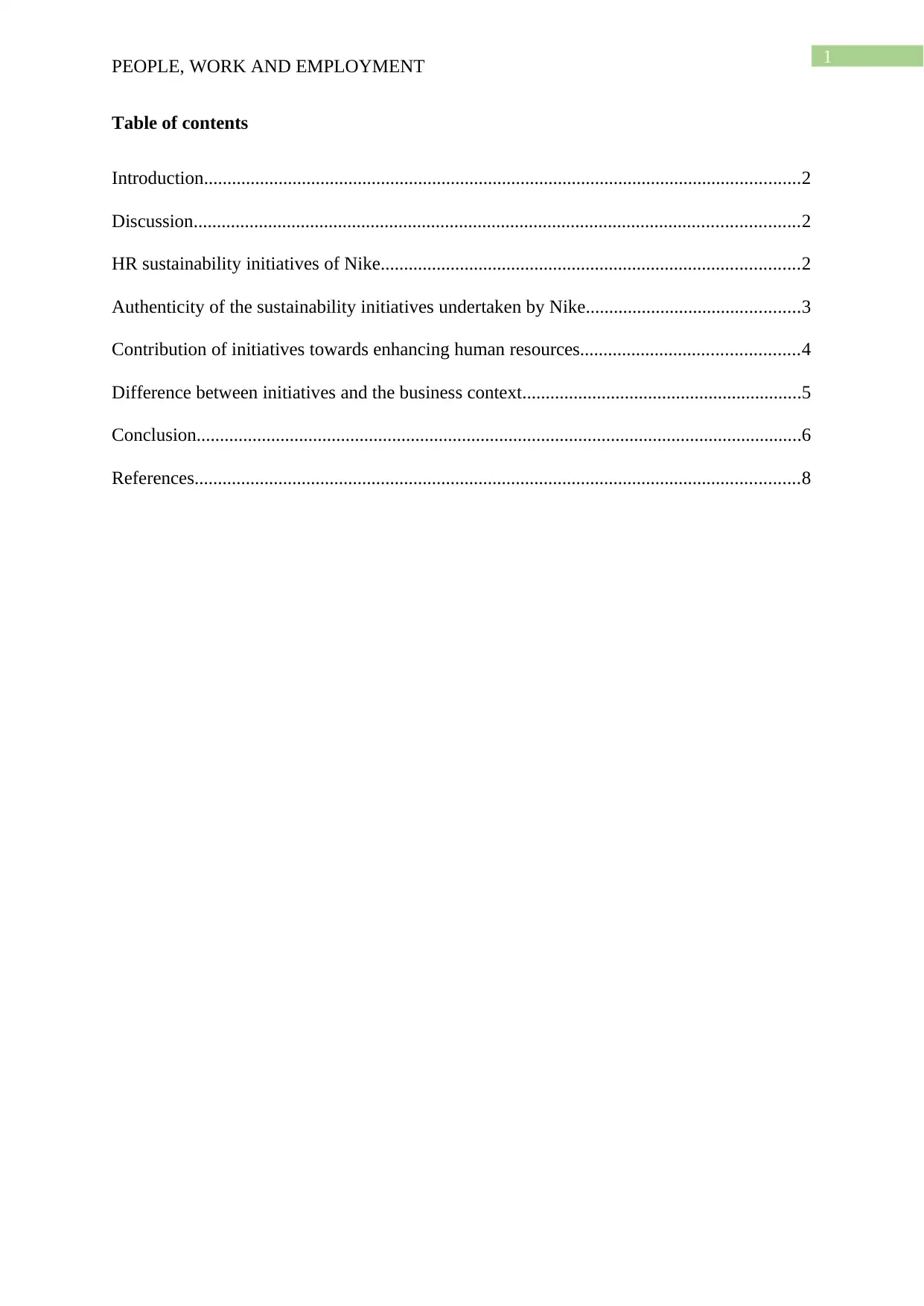
1
PEOPLE, WORK AND EMPLOYMENT
Table of contents
Introduction................................................................................................................................2
Discussion..................................................................................................................................2
HR sustainability initiatives of Nike..........................................................................................2
Authenticity of the sustainability initiatives undertaken by Nike..............................................3
Contribution of initiatives towards enhancing human resources...............................................4
Difference between initiatives and the business context............................................................5
Conclusion..................................................................................................................................6
References..................................................................................................................................8
PEOPLE, WORK AND EMPLOYMENT
Table of contents
Introduction................................................................................................................................2
Discussion..................................................................................................................................2
HR sustainability initiatives of Nike..........................................................................................2
Authenticity of the sustainability initiatives undertaken by Nike..............................................3
Contribution of initiatives towards enhancing human resources...............................................4
Difference between initiatives and the business context............................................................5
Conclusion..................................................................................................................................6
References..................................................................................................................................8
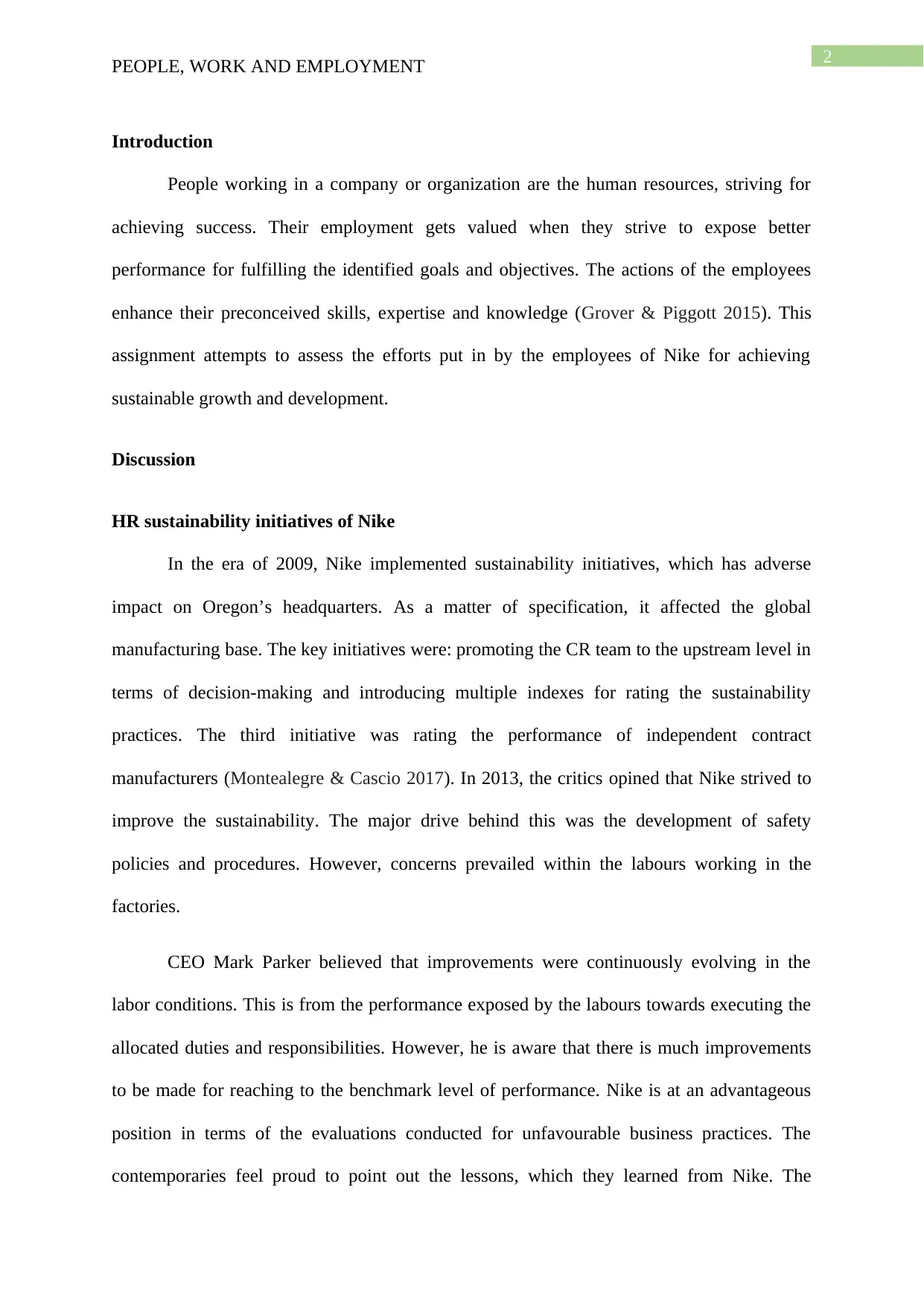
2
PEOPLE, WORK AND EMPLOYMENT
Introduction
People working in a company or organization are the human resources, striving for
achieving success. Their employment gets valued when they strive to expose better
performance for fulfilling the identified goals and objectives. The actions of the employees
enhance their preconceived skills, expertise and knowledge (Grover & Piggott 2015). This
assignment attempts to assess the efforts put in by the employees of Nike for achieving
sustainable growth and development.
Discussion
HR sustainability initiatives of Nike
In the era of 2009, Nike implemented sustainability initiatives, which has adverse
impact on Oregon’s headquarters. As a matter of specification, it affected the global
manufacturing base. The key initiatives were: promoting the CR team to the upstream level in
terms of decision-making and introducing multiple indexes for rating the sustainability
practices. The third initiative was rating the performance of independent contract
manufacturers (Montealegre & Cascio 2017). In 2013, the critics opined that Nike strived to
improve the sustainability. The major drive behind this was the development of safety
policies and procedures. However, concerns prevailed within the labours working in the
factories.
CEO Mark Parker believed that improvements were continuously evolving in the
labor conditions. This is from the performance exposed by the labours towards executing the
allocated duties and responsibilities. However, he is aware that there is much improvements
to be made for reaching to the benchmark level of performance. Nike is at an advantageous
position in terms of the evaluations conducted for unfavourable business practices. The
contemporaries feel proud to point out the lessons, which they learned from Nike. The
PEOPLE, WORK AND EMPLOYMENT
Introduction
People working in a company or organization are the human resources, striving for
achieving success. Their employment gets valued when they strive to expose better
performance for fulfilling the identified goals and objectives. The actions of the employees
enhance their preconceived skills, expertise and knowledge (Grover & Piggott 2015). This
assignment attempts to assess the efforts put in by the employees of Nike for achieving
sustainable growth and development.
Discussion
HR sustainability initiatives of Nike
In the era of 2009, Nike implemented sustainability initiatives, which has adverse
impact on Oregon’s headquarters. As a matter of specification, it affected the global
manufacturing base. The key initiatives were: promoting the CR team to the upstream level in
terms of decision-making and introducing multiple indexes for rating the sustainability
practices. The third initiative was rating the performance of independent contract
manufacturers (Montealegre & Cascio 2017). In 2013, the critics opined that Nike strived to
improve the sustainability. The major drive behind this was the development of safety
policies and procedures. However, concerns prevailed within the labours working in the
factories.
CEO Mark Parker believed that improvements were continuously evolving in the
labor conditions. This is from the performance exposed by the labours towards executing the
allocated duties and responsibilities. However, he is aware that there is much improvements
to be made for reaching to the benchmark level of performance. Nike is at an advantageous
position in terms of the evaluations conducted for unfavourable business practices. The
contemporaries feel proud to point out the lessons, which they learned from Nike. The
⊘ This is a preview!⊘
Do you want full access?
Subscribe today to unlock all pages.

Trusted by 1+ million students worldwide
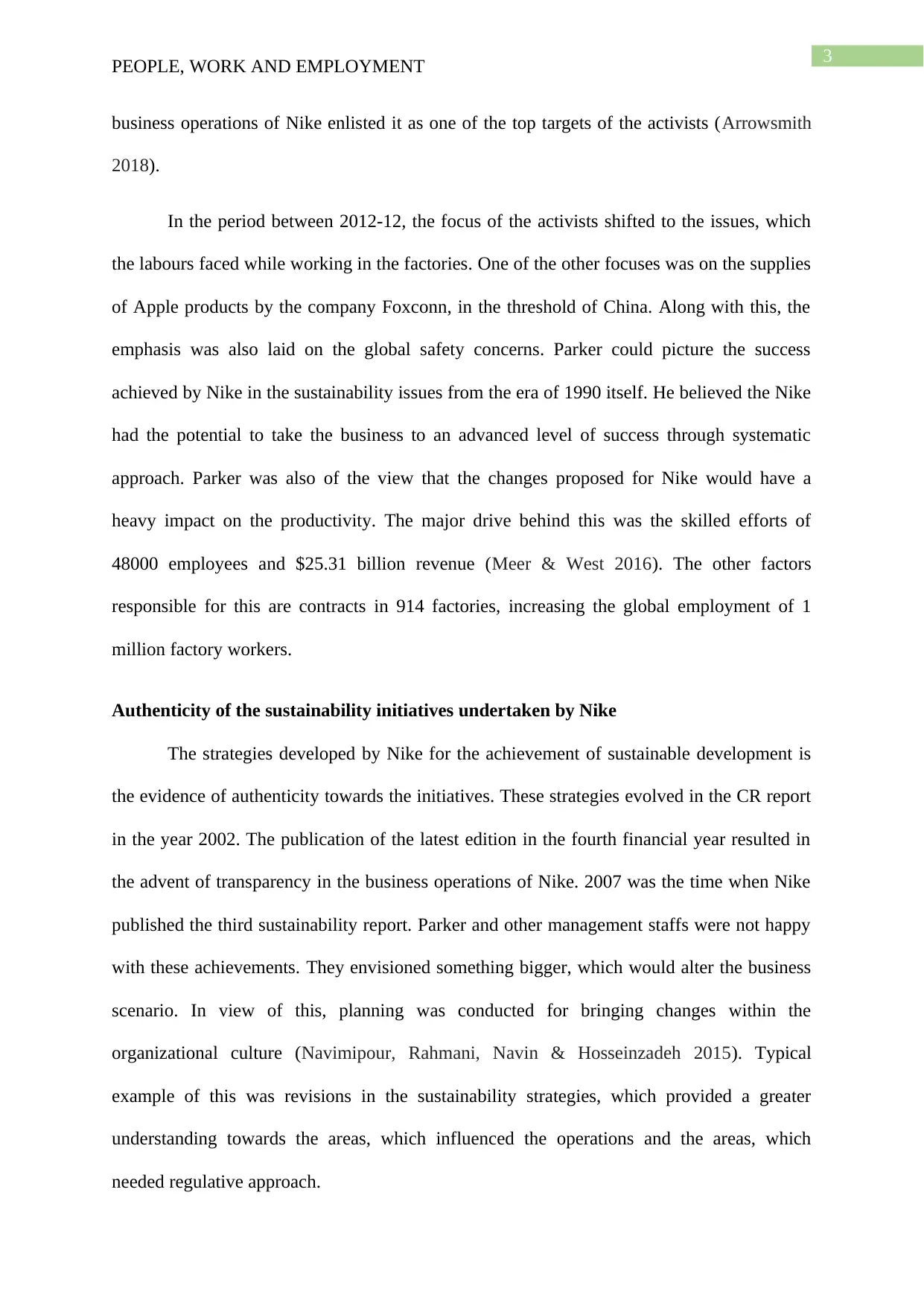
3
PEOPLE, WORK AND EMPLOYMENT
business operations of Nike enlisted it as one of the top targets of the activists (Arrowsmith
2018).
In the period between 2012-12, the focus of the activists shifted to the issues, which
the labours faced while working in the factories. One of the other focuses was on the supplies
of Apple products by the company Foxconn, in the threshold of China. Along with this, the
emphasis was also laid on the global safety concerns. Parker could picture the success
achieved by Nike in the sustainability issues from the era of 1990 itself. He believed the Nike
had the potential to take the business to an advanced level of success through systematic
approach. Parker was also of the view that the changes proposed for Nike would have a
heavy impact on the productivity. The major drive behind this was the skilled efforts of
48000 employees and $25.31 billion revenue (Meer & West 2016). The other factors
responsible for this are contracts in 914 factories, increasing the global employment of 1
million factory workers.
Authenticity of the sustainability initiatives undertaken by Nike
The strategies developed by Nike for the achievement of sustainable development is
the evidence of authenticity towards the initiatives. These strategies evolved in the CR report
in the year 2002. The publication of the latest edition in the fourth financial year resulted in
the advent of transparency in the business operations of Nike. 2007 was the time when Nike
published the third sustainability report. Parker and other management staffs were not happy
with these achievements. They envisioned something bigger, which would alter the business
scenario. In view of this, planning was conducted for bringing changes within the
organizational culture (Navimipour, Rahmani, Navin & Hosseinzadeh 2015). Typical
example of this was revisions in the sustainability strategies, which provided a greater
understanding towards the areas, which influenced the operations and the areas, which
needed regulative approach.
PEOPLE, WORK AND EMPLOYMENT
business operations of Nike enlisted it as one of the top targets of the activists (Arrowsmith
2018).
In the period between 2012-12, the focus of the activists shifted to the issues, which
the labours faced while working in the factories. One of the other focuses was on the supplies
of Apple products by the company Foxconn, in the threshold of China. Along with this, the
emphasis was also laid on the global safety concerns. Parker could picture the success
achieved by Nike in the sustainability issues from the era of 1990 itself. He believed the Nike
had the potential to take the business to an advanced level of success through systematic
approach. Parker was also of the view that the changes proposed for Nike would have a
heavy impact on the productivity. The major drive behind this was the skilled efforts of
48000 employees and $25.31 billion revenue (Meer & West 2016). The other factors
responsible for this are contracts in 914 factories, increasing the global employment of 1
million factory workers.
Authenticity of the sustainability initiatives undertaken by Nike
The strategies developed by Nike for the achievement of sustainable development is
the evidence of authenticity towards the initiatives. These strategies evolved in the CR report
in the year 2002. The publication of the latest edition in the fourth financial year resulted in
the advent of transparency in the business operations of Nike. 2007 was the time when Nike
published the third sustainability report. Parker and other management staffs were not happy
with these achievements. They envisioned something bigger, which would alter the business
scenario. In view of this, planning was conducted for bringing changes within the
organizational culture (Navimipour, Rahmani, Navin & Hosseinzadeh 2015). Typical
example of this was revisions in the sustainability strategies, which provided a greater
understanding towards the areas, which influenced the operations and the areas, which
needed regulative approach.
Paraphrase This Document
Need a fresh take? Get an instant paraphrase of this document with our AI Paraphraser
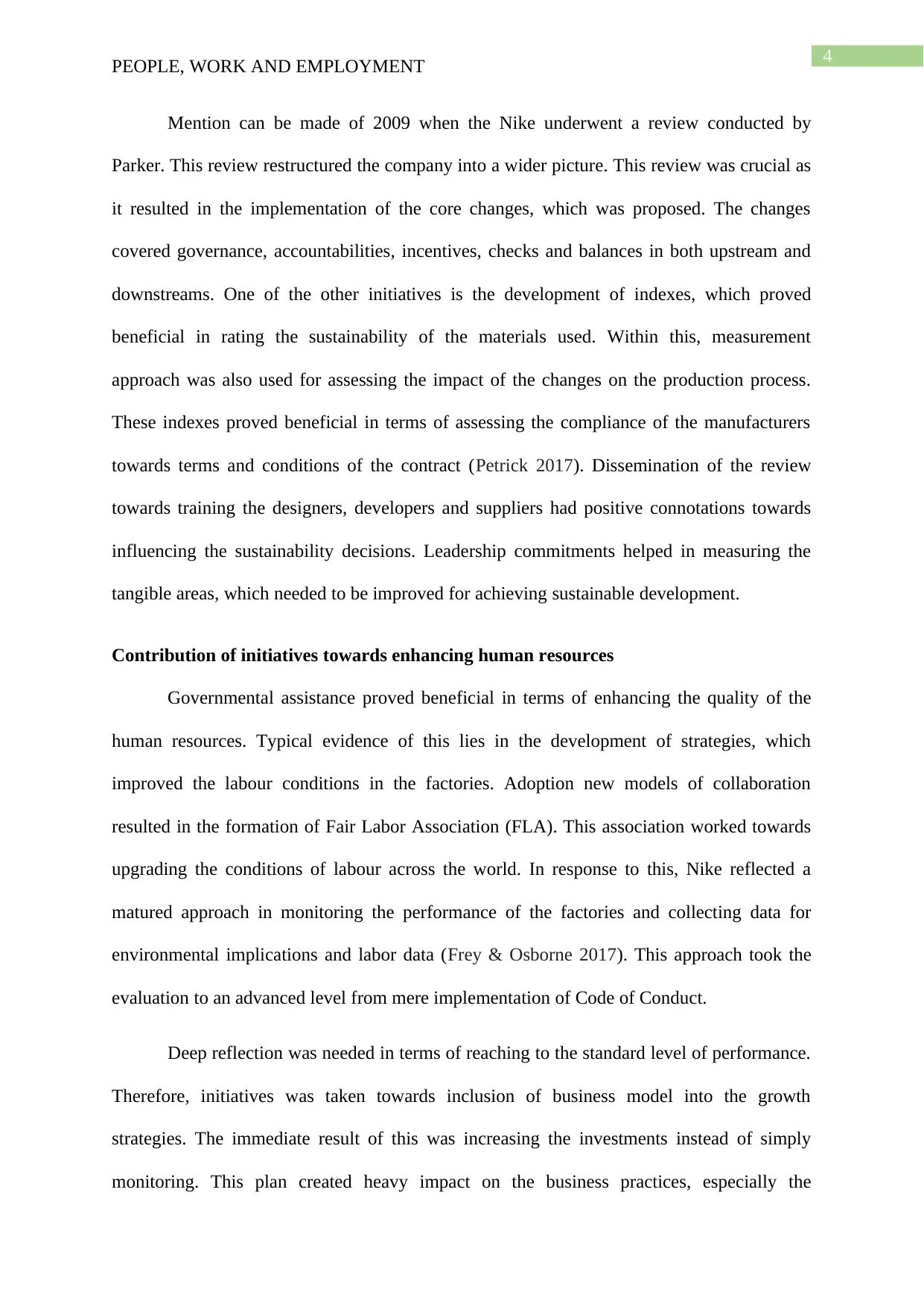
4
PEOPLE, WORK AND EMPLOYMENT
Mention can be made of 2009 when the Nike underwent a review conducted by
Parker. This review restructured the company into a wider picture. This review was crucial as
it resulted in the implementation of the core changes, which was proposed. The changes
covered governance, accountabilities, incentives, checks and balances in both upstream and
downstreams. One of the other initiatives is the development of indexes, which proved
beneficial in rating the sustainability of the materials used. Within this, measurement
approach was also used for assessing the impact of the changes on the production process.
These indexes proved beneficial in terms of assessing the compliance of the manufacturers
towards terms and conditions of the contract (Petrick 2017). Dissemination of the review
towards training the designers, developers and suppliers had positive connotations towards
influencing the sustainability decisions. Leadership commitments helped in measuring the
tangible areas, which needed to be improved for achieving sustainable development.
Contribution of initiatives towards enhancing human resources
Governmental assistance proved beneficial in terms of enhancing the quality of the
human resources. Typical evidence of this lies in the development of strategies, which
improved the labour conditions in the factories. Adoption new models of collaboration
resulted in the formation of Fair Labor Association (FLA). This association worked towards
upgrading the conditions of labour across the world. In response to this, Nike reflected a
matured approach in monitoring the performance of the factories and collecting data for
environmental implications and labor data (Frey & Osborne 2017). This approach took the
evaluation to an advanced level from mere implementation of Code of Conduct.
Deep reflection was needed in terms of reaching to the standard level of performance.
Therefore, initiatives was taken towards inclusion of business model into the growth
strategies. The immediate result of this was increasing the investments instead of simply
monitoring. This plan created heavy impact on the business practices, especially the
PEOPLE, WORK AND EMPLOYMENT
Mention can be made of 2009 when the Nike underwent a review conducted by
Parker. This review restructured the company into a wider picture. This review was crucial as
it resulted in the implementation of the core changes, which was proposed. The changes
covered governance, accountabilities, incentives, checks and balances in both upstream and
downstreams. One of the other initiatives is the development of indexes, which proved
beneficial in rating the sustainability of the materials used. Within this, measurement
approach was also used for assessing the impact of the changes on the production process.
These indexes proved beneficial in terms of assessing the compliance of the manufacturers
towards terms and conditions of the contract (Petrick 2017). Dissemination of the review
towards training the designers, developers and suppliers had positive connotations towards
influencing the sustainability decisions. Leadership commitments helped in measuring the
tangible areas, which needed to be improved for achieving sustainable development.
Contribution of initiatives towards enhancing human resources
Governmental assistance proved beneficial in terms of enhancing the quality of the
human resources. Typical evidence of this lies in the development of strategies, which
improved the labour conditions in the factories. Adoption new models of collaboration
resulted in the formation of Fair Labor Association (FLA). This association worked towards
upgrading the conditions of labour across the world. In response to this, Nike reflected a
matured approach in monitoring the performance of the factories and collecting data for
environmental implications and labor data (Frey & Osborne 2017). This approach took the
evaluation to an advanced level from mere implementation of Code of Conduct.
Deep reflection was needed in terms of reaching to the standard level of performance.
Therefore, initiatives was taken towards inclusion of business model into the growth
strategies. The immediate result of this was increasing the investments instead of simply
monitoring. This plan created heavy impact on the business practices, especially the
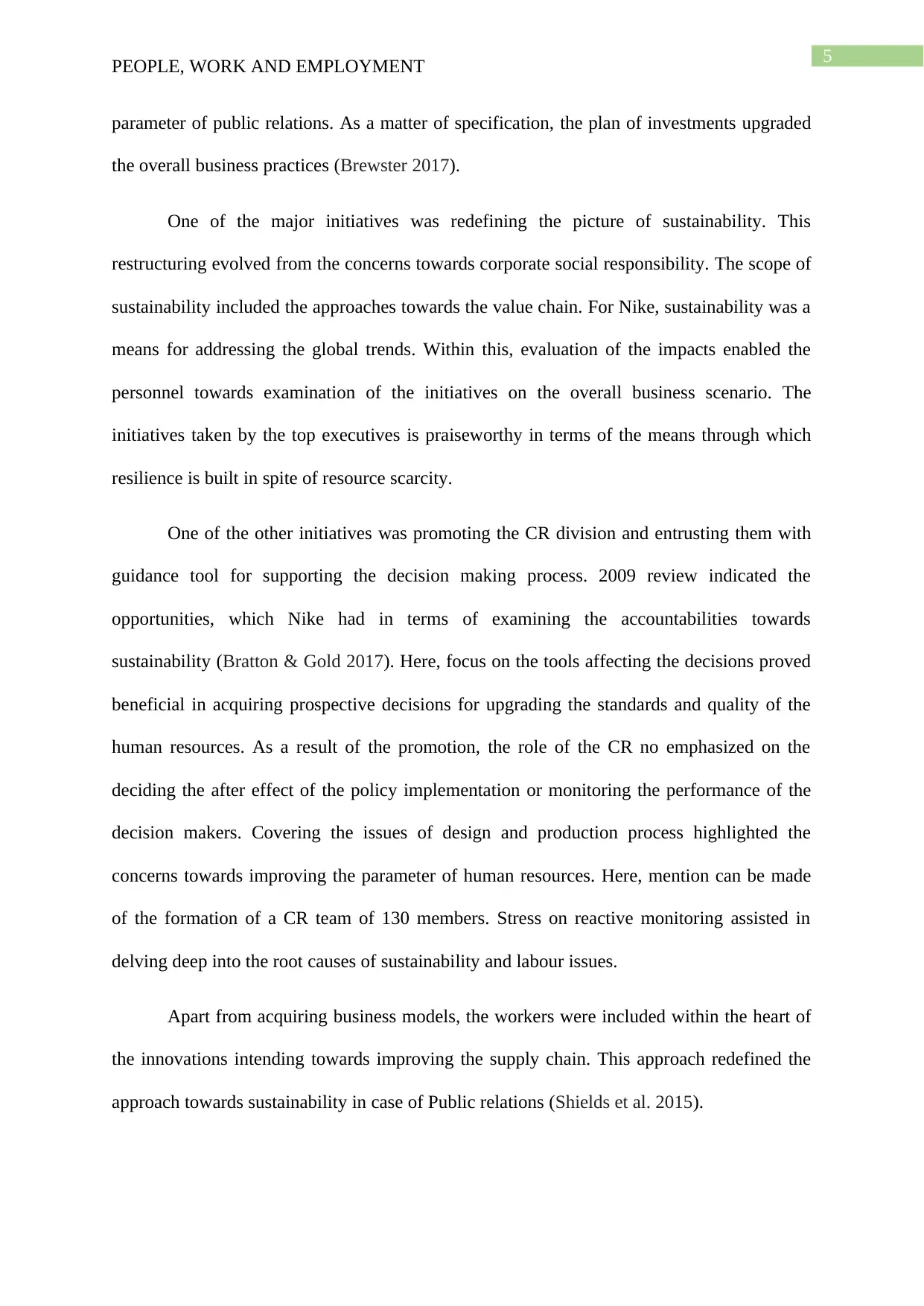
5
PEOPLE, WORK AND EMPLOYMENT
parameter of public relations. As a matter of specification, the plan of investments upgraded
the overall business practices (Brewster 2017).
One of the major initiatives was redefining the picture of sustainability. This
restructuring evolved from the concerns towards corporate social responsibility. The scope of
sustainability included the approaches towards the value chain. For Nike, sustainability was a
means for addressing the global trends. Within this, evaluation of the impacts enabled the
personnel towards examination of the initiatives on the overall business scenario. The
initiatives taken by the top executives is praiseworthy in terms of the means through which
resilience is built in spite of resource scarcity.
One of the other initiatives was promoting the CR division and entrusting them with
guidance tool for supporting the decision making process. 2009 review indicated the
opportunities, which Nike had in terms of examining the accountabilities towards
sustainability (Bratton & Gold 2017). Here, focus on the tools affecting the decisions proved
beneficial in acquiring prospective decisions for upgrading the standards and quality of the
human resources. As a result of the promotion, the role of the CR no emphasized on the
deciding the after effect of the policy implementation or monitoring the performance of the
decision makers. Covering the issues of design and production process highlighted the
concerns towards improving the parameter of human resources. Here, mention can be made
of the formation of a CR team of 130 members. Stress on reactive monitoring assisted in
delving deep into the root causes of sustainability and labour issues.
Apart from acquiring business models, the workers were included within the heart of
the innovations intending towards improving the supply chain. This approach redefined the
approach towards sustainability in case of Public relations (Shields et al. 2015).
PEOPLE, WORK AND EMPLOYMENT
parameter of public relations. As a matter of specification, the plan of investments upgraded
the overall business practices (Brewster 2017).
One of the major initiatives was redefining the picture of sustainability. This
restructuring evolved from the concerns towards corporate social responsibility. The scope of
sustainability included the approaches towards the value chain. For Nike, sustainability was a
means for addressing the global trends. Within this, evaluation of the impacts enabled the
personnel towards examination of the initiatives on the overall business scenario. The
initiatives taken by the top executives is praiseworthy in terms of the means through which
resilience is built in spite of resource scarcity.
One of the other initiatives was promoting the CR division and entrusting them with
guidance tool for supporting the decision making process. 2009 review indicated the
opportunities, which Nike had in terms of examining the accountabilities towards
sustainability (Bratton & Gold 2017). Here, focus on the tools affecting the decisions proved
beneficial in acquiring prospective decisions for upgrading the standards and quality of the
human resources. As a result of the promotion, the role of the CR no emphasized on the
deciding the after effect of the policy implementation or monitoring the performance of the
decision makers. Covering the issues of design and production process highlighted the
concerns towards improving the parameter of human resources. Here, mention can be made
of the formation of a CR team of 130 members. Stress on reactive monitoring assisted in
delving deep into the root causes of sustainability and labour issues.
Apart from acquiring business models, the workers were included within the heart of
the innovations intending towards improving the supply chain. This approach redefined the
approach towards sustainability in case of Public relations (Shields et al. 2015).
⊘ This is a preview!⊘
Do you want full access?
Subscribe today to unlock all pages.

Trusted by 1+ million students worldwide
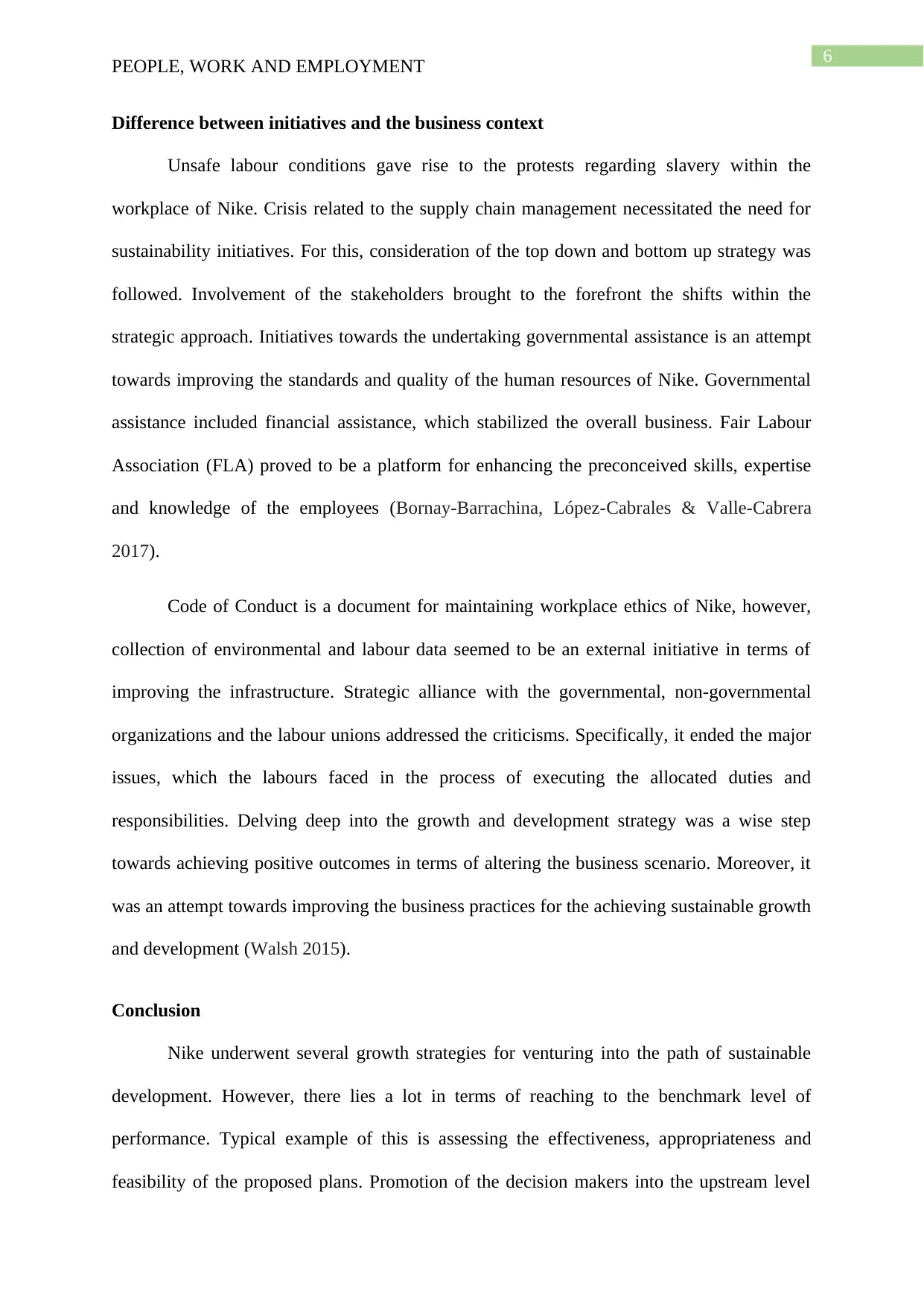
6
PEOPLE, WORK AND EMPLOYMENT
Difference between initiatives and the business context
Unsafe labour conditions gave rise to the protests regarding slavery within the
workplace of Nike. Crisis related to the supply chain management necessitated the need for
sustainability initiatives. For this, consideration of the top down and bottom up strategy was
followed. Involvement of the stakeholders brought to the forefront the shifts within the
strategic approach. Initiatives towards the undertaking governmental assistance is an attempt
towards improving the standards and quality of the human resources of Nike. Governmental
assistance included financial assistance, which stabilized the overall business. Fair Labour
Association (FLA) proved to be a platform for enhancing the preconceived skills, expertise
and knowledge of the employees (Bornay-Barrachina, López-Cabrales & Valle-Cabrera
2017).
Code of Conduct is a document for maintaining workplace ethics of Nike, however,
collection of environmental and labour data seemed to be an external initiative in terms of
improving the infrastructure. Strategic alliance with the governmental, non-governmental
organizations and the labour unions addressed the criticisms. Specifically, it ended the major
issues, which the labours faced in the process of executing the allocated duties and
responsibilities. Delving deep into the growth and development strategy was a wise step
towards achieving positive outcomes in terms of altering the business scenario. Moreover, it
was an attempt towards improving the business practices for the achieving sustainable growth
and development (Walsh 2015).
Conclusion
Nike underwent several growth strategies for venturing into the path of sustainable
development. However, there lies a lot in terms of reaching to the benchmark level of
performance. Typical example of this is assessing the effectiveness, appropriateness and
feasibility of the proposed plans. Promotion of the decision makers into the upstream level
PEOPLE, WORK AND EMPLOYMENT
Difference between initiatives and the business context
Unsafe labour conditions gave rise to the protests regarding slavery within the
workplace of Nike. Crisis related to the supply chain management necessitated the need for
sustainability initiatives. For this, consideration of the top down and bottom up strategy was
followed. Involvement of the stakeholders brought to the forefront the shifts within the
strategic approach. Initiatives towards the undertaking governmental assistance is an attempt
towards improving the standards and quality of the human resources of Nike. Governmental
assistance included financial assistance, which stabilized the overall business. Fair Labour
Association (FLA) proved to be a platform for enhancing the preconceived skills, expertise
and knowledge of the employees (Bornay-Barrachina, López-Cabrales & Valle-Cabrera
2017).
Code of Conduct is a document for maintaining workplace ethics of Nike, however,
collection of environmental and labour data seemed to be an external initiative in terms of
improving the infrastructure. Strategic alliance with the governmental, non-governmental
organizations and the labour unions addressed the criticisms. Specifically, it ended the major
issues, which the labours faced in the process of executing the allocated duties and
responsibilities. Delving deep into the growth and development strategy was a wise step
towards achieving positive outcomes in terms of altering the business scenario. Moreover, it
was an attempt towards improving the business practices for the achieving sustainable growth
and development (Walsh 2015).
Conclusion
Nike underwent several growth strategies for venturing into the path of sustainable
development. However, there lies a lot in terms of reaching to the benchmark level of
performance. Typical example of this is assessing the effectiveness, appropriateness and
feasibility of the proposed plans. Promotion of the decision makers into the upstream level
Paraphrase This Document
Need a fresh take? Get an instant paraphrase of this document with our AI Paraphraser
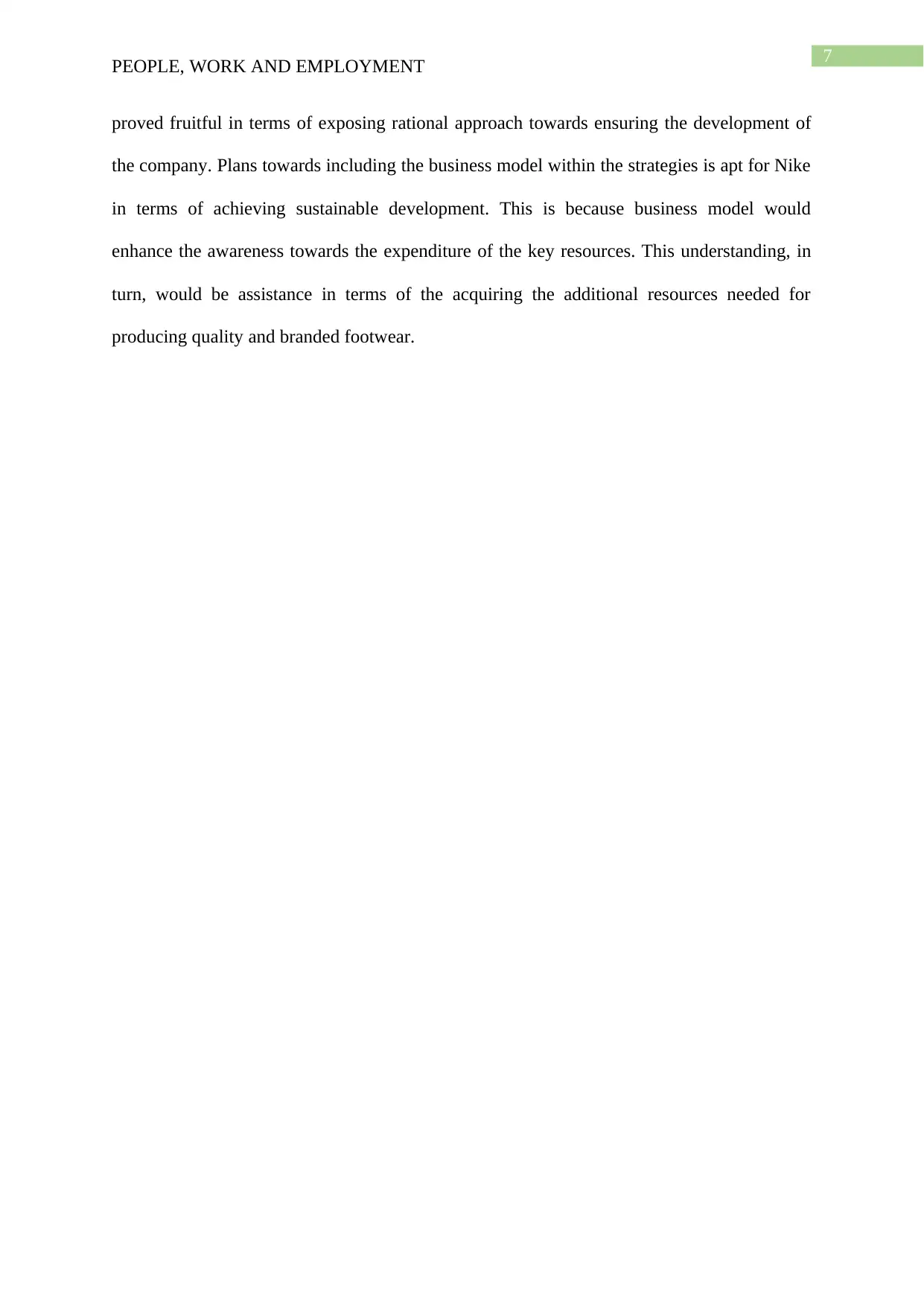
7
PEOPLE, WORK AND EMPLOYMENT
proved fruitful in terms of exposing rational approach towards ensuring the development of
the company. Plans towards including the business model within the strategies is apt for Nike
in terms of achieving sustainable development. This is because business model would
enhance the awareness towards the expenditure of the key resources. This understanding, in
turn, would be assistance in terms of the acquiring the additional resources needed for
producing quality and branded footwear.
PEOPLE, WORK AND EMPLOYMENT
proved fruitful in terms of exposing rational approach towards ensuring the development of
the company. Plans towards including the business model within the strategies is apt for Nike
in terms of achieving sustainable development. This is because business model would
enhance the awareness towards the expenditure of the key resources. This understanding, in
turn, would be assistance in terms of the acquiring the additional resources needed for
producing quality and branded footwear.
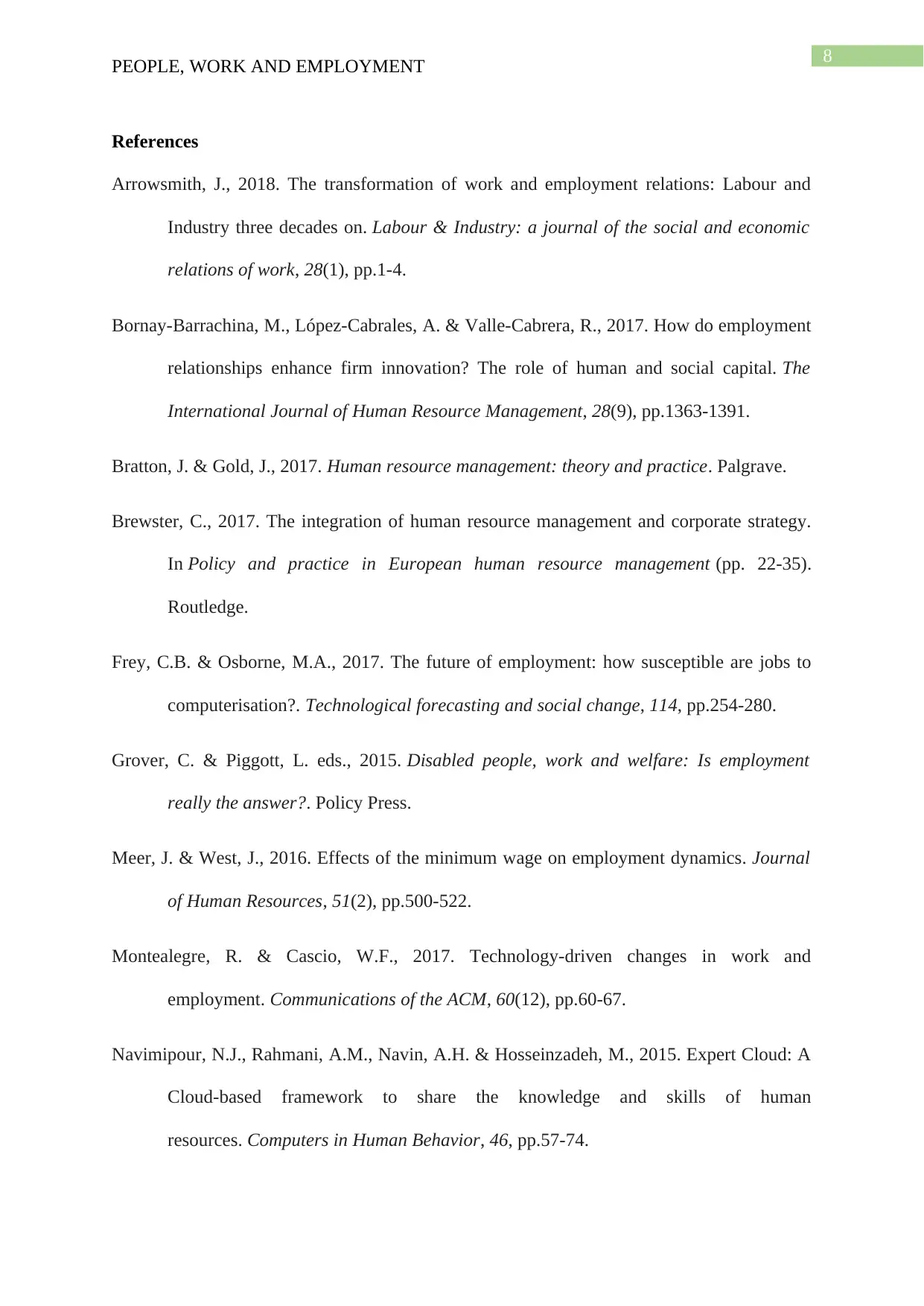
8
PEOPLE, WORK AND EMPLOYMENT
References
Arrowsmith, J., 2018. The transformation of work and employment relations: Labour and
Industry three decades on. Labour & Industry: a journal of the social and economic
relations of work, 28(1), pp.1-4.
Bornay-Barrachina, M., López-Cabrales, A. & Valle-Cabrera, R., 2017. How do employment
relationships enhance firm innovation? The role of human and social capital. The
International Journal of Human Resource Management, 28(9), pp.1363-1391.
Bratton, J. & Gold, J., 2017. Human resource management: theory and practice. Palgrave.
Brewster, C., 2017. The integration of human resource management and corporate strategy.
In Policy and practice in European human resource management (pp. 22-35).
Routledge.
Frey, C.B. & Osborne, M.A., 2017. The future of employment: how susceptible are jobs to
computerisation?. Technological forecasting and social change, 114, pp.254-280.
Grover, C. & Piggott, L. eds., 2015. Disabled people, work and welfare: Is employment
really the answer?. Policy Press.
Meer, J. & West, J., 2016. Effects of the minimum wage on employment dynamics. Journal
of Human Resources, 51(2), pp.500-522.
Montealegre, R. & Cascio, W.F., 2017. Technology-driven changes in work and
employment. Communications of the ACM, 60(12), pp.60-67.
Navimipour, N.J., Rahmani, A.M., Navin, A.H. & Hosseinzadeh, M., 2015. Expert Cloud: A
Cloud-based framework to share the knowledge and skills of human
resources. Computers in Human Behavior, 46, pp.57-74.
PEOPLE, WORK AND EMPLOYMENT
References
Arrowsmith, J., 2018. The transformation of work and employment relations: Labour and
Industry three decades on. Labour & Industry: a journal of the social and economic
relations of work, 28(1), pp.1-4.
Bornay-Barrachina, M., López-Cabrales, A. & Valle-Cabrera, R., 2017. How do employment
relationships enhance firm innovation? The role of human and social capital. The
International Journal of Human Resource Management, 28(9), pp.1363-1391.
Bratton, J. & Gold, J., 2017. Human resource management: theory and practice. Palgrave.
Brewster, C., 2017. The integration of human resource management and corporate strategy.
In Policy and practice in European human resource management (pp. 22-35).
Routledge.
Frey, C.B. & Osborne, M.A., 2017. The future of employment: how susceptible are jobs to
computerisation?. Technological forecasting and social change, 114, pp.254-280.
Grover, C. & Piggott, L. eds., 2015. Disabled people, work and welfare: Is employment
really the answer?. Policy Press.
Meer, J. & West, J., 2016. Effects of the minimum wage on employment dynamics. Journal
of Human Resources, 51(2), pp.500-522.
Montealegre, R. & Cascio, W.F., 2017. Technology-driven changes in work and
employment. Communications of the ACM, 60(12), pp.60-67.
Navimipour, N.J., Rahmani, A.M., Navin, A.H. & Hosseinzadeh, M., 2015. Expert Cloud: A
Cloud-based framework to share the knowledge and skills of human
resources. Computers in Human Behavior, 46, pp.57-74.
⊘ This is a preview!⊘
Do you want full access?
Subscribe today to unlock all pages.

Trusted by 1+ million students worldwide
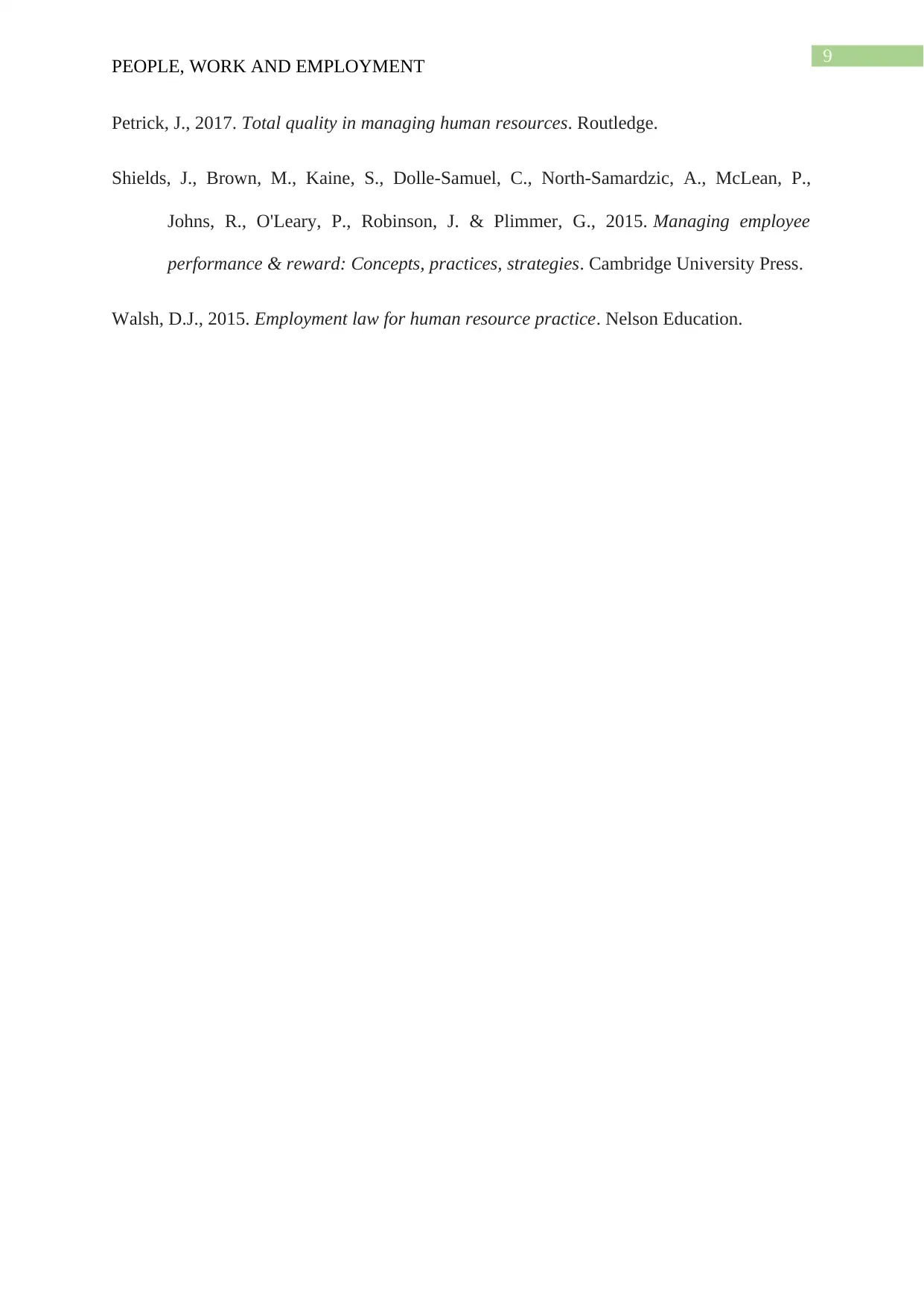
9
PEOPLE, WORK AND EMPLOYMENT
Petrick, J., 2017. Total quality in managing human resources. Routledge.
Shields, J., Brown, M., Kaine, S., Dolle-Samuel, C., North-Samardzic, A., McLean, P.,
Johns, R., O'Leary, P., Robinson, J. & Plimmer, G., 2015. Managing employee
performance & reward: Concepts, practices, strategies. Cambridge University Press.
Walsh, D.J., 2015. Employment law for human resource practice. Nelson Education.
PEOPLE, WORK AND EMPLOYMENT
Petrick, J., 2017. Total quality in managing human resources. Routledge.
Shields, J., Brown, M., Kaine, S., Dolle-Samuel, C., North-Samardzic, A., McLean, P.,
Johns, R., O'Leary, P., Robinson, J. & Plimmer, G., 2015. Managing employee
performance & reward: Concepts, practices, strategies. Cambridge University Press.
Walsh, D.J., 2015. Employment law for human resource practice. Nelson Education.
1 out of 10
Related Documents
Your All-in-One AI-Powered Toolkit for Academic Success.
+13062052269
info@desklib.com
Available 24*7 on WhatsApp / Email
![[object Object]](/_next/static/media/star-bottom.7253800d.svg)
Unlock your academic potential
Copyright © 2020–2025 A2Z Services. All Rights Reserved. Developed and managed by ZUCOL.





